Vintage Baths Design
It was at the dawn of the 20th century that elaborate preparations for indoor bathing began to distinguish the domestic architecture of the day. The old dark wood one per household five-by-eight bathroom, with its minimum of light and its dark walnut wainscot and sheathing combined with the untempting tin or copper tub was discarded. The 1900s had luxurious bathroom fixtures. You can compare original vintage bathroom fixtures with today’s to recreate an authentic vintage bath design while still retaining the current innovations and conveniences of modern bathroom plumbing. |
|
Eye-Catching Tubs for Vintage Baths |
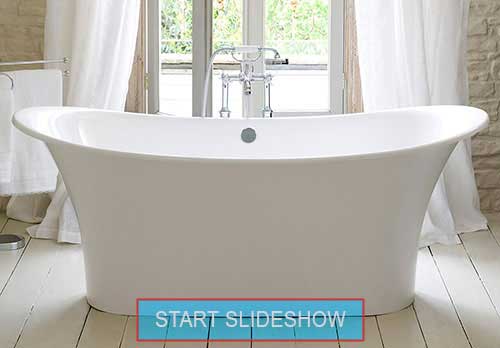
|
Vintage Bath: The above vintage tub is one of the series featured by Victoria & Albert. It is a 64 inch freestanding vintage bath and tub. The freestanding classic Toulouse double-ended bateau tub features a deep, double-ended bathing well. The freestanding design will be the anchor point of your vintage bath. Comes complete with integral base and internal overflow. |
Online Design Tools Plan your vintage bathroom in a three-dimensional environment by using online bath design tools.. You can create a virtual design from your own floor plan. With online tools you can change the floor plans, change the colors of the products, add a whirlpool, or paint the walls. Also featuring the ability to save and print your favorite bath design along with faucet model numbers and prices. You can even place a person in your virtual bathroom to give you an idea of how much room you have to move around in. |
The first necessity for this new vintage bathroom was that it should be sanitary - sanitary first and beautiful afterwards. By the turn-of-the-century homeowners reached the point where they began to realize what sanitary meant. Not only were the bathrooms no longer built of wood, but the plumbing was now always open to to view. Hiding places for water-bugs and accumulations of dirt and dust were carefully avoided with every inch open to light, air, and the application of soap and water.
|
Cost of Adding a Bathroom |
 A hundred plus years ago, Iron waste-pipes were universally used, but iron supply pipes, although the cheapest, were condemned because they were inclined to rust. Lead piping was thought to be much better for a vintage bath although with certain kinds of water the lead was sometimes dissolved sufficiently to make the water poisonous for drinking. Brass pipes were deemed best, especially for hot water. These were all nickel-plated in the most attractive bathrooms because the nickel plate could be kept clean and shining with comparatively little labor. It was necessary, however, to polish it frequently because any neglected parts quickly became covered with a greenish-gray oxide which was very hard to remove. The proud housewife paid attention that the plumbing in her vintage bathroom was kept with most scrupulous care with every pipe being made to shine like the silver on one's table. Today, the subject of piping in a vintage bath requires some consideration in building a new bathroom or in re-piping an old one. When adding an extra bathroom to a house, it is less expensive to have the fixtures installed on one “wet wall” - that is the one with the current piping. Try to add your bathroom under, over, or next to another bath, kitchen, or laundry room. The farther you go from existing plumbing, the higher the cost of adding a bathroom. |
Bathroom Floor Plans |
|
As much thought was given vintage bathroom color scheme and decoration as to any other room in the house. The homeowner gave as much space to their bathrooms as possible, followed by much sunlight and fresh air through a variety In the matter of vintage bathroom fixtures, many changes also took place at this time. The tub and the basin no longer completed the room. There was the shower, the sitz, and the foot tub as well—each of porcelain and each with its nickel-plated pipes. The most common material for the tubs and washbasins was solid white porcelain since most could not afford the hollowed-out blocks of marble of millionaires. Porcelain was non-absorbent, looked clean and was easily kept clean. |
|
|
In the more elaborately fitted-out vintage bath, there were the shower-bath, the shampoo attachment, the sitz bath, and the foot bath—all delightful luxuries. The simpler showers, which were attached over the tub with the necessary fixtures directly in back of it and the rubber curtain hanging down into the tub or behind it, were not extravagant luxuries, as a result, they were found in many modern homes. There were also more elaborate showers with porcelain bases that were much more expensive. Another costly fixture was the needle-bath, with the shower spraying from circular pipes on all sides as well as from above. The sitz and the foot bath were also made of the same material as the large tubs, and with stationary faucets and pipes so that the carrying of water was avoided. |
|
Tile Design for Vintage Bath |
The ideal covering for the walls and floor of a bathroom was marble or tiles, but very few could afford either the marble or an entire covering of tiles. Antique tiles, however, were sometimes used to advantage merely for a wainscot, or, if possible, for a wainscot and floor, leaving the upper wall, which was not directly exposed to the water for another For those who could not afford marble or tile, it was necessary to use materials for floors that were made non-absorbent. Soft wood floors would be covered with linoleum. By the beginning of the 20th century, linoleum designs were made reproducing tile and mosaic effects in blue and white, black and white, and other color combinations. They were very attractive and thought to be barely distinguishable from the real tiles. |
|
A hardwood floor was oiled, shellacked, or waxed after all the cracks had been carefully filled. This protective treatment would be repeated frequently. Old hardwood floors were often painted with white enamel paint. Combining daintily colored walls, a white standing finish, porcelain or enamel fittings, and nickel-plated fixtures made these less expensive rooms almost as attractive as those with the white tile floors and wainscot. The most appropriate rugs for the floor were the hand-woven cotton rugs frequently recommended for bedrooms. They were made in any color and were usually washable. Besides the permanent rug on the floor there were cork mats or Turkish toweling, which was removed after each bath. |
Simple leaded glass windows with colored glass were especially appropriate for the modern 1900s bathroom since they rendered curtains unnecessary; but an elaborate "art glass" was deemed very much out of place. Without the colored glass, shades were a necessity at night and curtains in the daytime. The window treatment would be of a washable material gathered on rods, without ruffles or draping, and hung from poles, reaching only to the sill. |
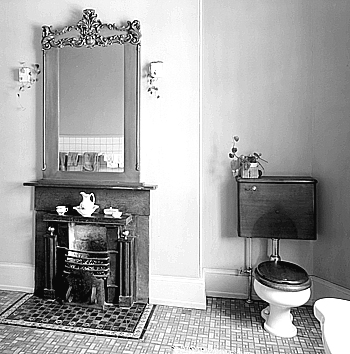 The assortment of accessories available for the new vintage bath was both grand and charming. Open fireplaces were built, chairs or marble seats provided, and perfumes, powders, nail files, and the rest, arranged in cut glass or silver, were available. The sponges and soap were kept in silver racks or on decorated porcelain dishes. Embroidered towels hung in profusion. Everything was either nickel-plated or plate glass. Shelves were often of plate glass, and towel-rods and tabletops were made of glass also. In the nickel plate there were innumerable towel racks of all sizes, either with swinging arms or attached at both ends. There were soiled-towel receptacles, soap-dishes of all descriptions for tub or shelf, sponge-holders for all sizes of sponges, tumbler-holders, tooth-brush racks, comb and brush trays, and hooks, large and small, all in the same shining metal. Mirrors with narrow white flat frames were hung flat against the wall over the basin or inserted into the wall. Medicine cabinets in white enamel with a mirror inserted in the door hung over the basin or on the side wall. If the bathroom was large enough a cabinet for towels was a great addition; an extra table or a dressing-table was a positive luxury. A small bathroom scale in white enamel allowed the members of the family to keep a careful watch of their weight. |
Sources: Harper's Bazaar, 1900-1907. Images: Library of Congress: The Historic American Buildings Survey and the Historic American Engineering Record |
Bathroom Design Tools

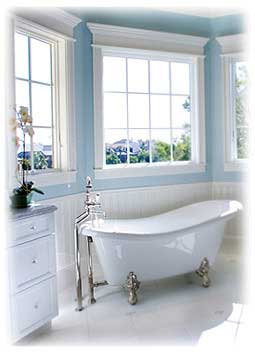 In the early 1900s, the old one-per-household five-by-eight vintage baths were replaced with the latest in bathroom invention and design. The shining cleanliness of the new piping of the turn-of-the-century bathroom was beautiful, but when the homeowner added to that the attraction of white porcelain and tiles, white woodwork, polished nickel-plated fixtures, and the dainty light colors of walls and furnishings, the room became an important design feature of the home. Today, the
In the early 1900s, the old one-per-household five-by-eight vintage baths were replaced with the latest in bathroom invention and design. The shining cleanliness of the new piping of the turn-of-the-century bathroom was beautiful, but when the homeowner added to that the attraction of white porcelain and tiles, white woodwork, polished nickel-plated fixtures, and the dainty light colors of walls and furnishings, the room became an important design feature of the home. Today, the 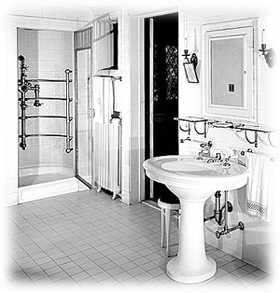 In the early 1900s, vintage bath fixtures became so elaborate in number and quality, that the conveniences home owners had in their bathroom were limited only by one's purse. The leading manufacturers at this time anticipated the dreams of the home owner and provided the most luxurious bathroom fixtures. Moreover, the well-to-do home owner was no longer content with just one bathroom for the family or even a bathroom on every floor—now each individual possessed his or her own personal bathroom. Furthermore, a guest of the home would not be permitted to skip a hurried way down the hall in search of a tub, but would have access to their own private space.
In the early 1900s, vintage bath fixtures became so elaborate in number and quality, that the conveniences home owners had in their bathroom were limited only by one's purse. The leading manufacturers at this time anticipated the dreams of the home owner and provided the most luxurious bathroom fixtures. Moreover, the well-to-do home owner was no longer content with just one bathroom for the family or even a bathroom on every floor—now each individual possessed his or her own personal bathroom. Furthermore, a guest of the home would not be permitted to skip a hurried way down the hall in search of a tub, but would have access to their own private space. 
 of
of  The solid porcelain tubs were still very expensive, however, and sometimes too heavy for a floor not prepared especially for them. Porcelain enameled ware was a material halfway in price between solid porcelain and the ordinary enameled iron, but still answering the requirements as well as the solid porcelain. It was a peculiar combination of porcelain enamel and prepared iron, which was warranted not to crack or discolor. The basins and tubs all came in one solid piece without joints, and there were innumerable graceful designs. There were basins with standards and without standards, with nickel or enamel legs, or supported and attached to the walls by means of brackets. The bowls were generous in size, the protecting shield in back broad or narrow, as desired, or utterly lacking if a tile or marble wall was planned for behind the fixture.
The solid porcelain tubs were still very expensive, however, and sometimes too heavy for a floor not prepared especially for them. Porcelain enameled ware was a material halfway in price between solid porcelain and the ordinary enameled iron, but still answering the requirements as well as the solid porcelain. It was a peculiar combination of porcelain enamel and prepared iron, which was warranted not to crack or discolor. The basins and tubs all came in one solid piece without joints, and there were innumerable graceful designs. There were basins with standards and without standards, with nickel or enamel legs, or supported and attached to the walls by means of brackets. The bowls were generous in size, the protecting shield in back broad or narrow, as desired, or utterly lacking if a tile or marble wall was planned for behind the fixture. Tubs were long or short, round at both ends, with the nickel-plated fixture in the middle, or square at one end and curved at the other, with the fixtures at the end. These
Tubs were long or short, round at both ends, with the nickel-plated fixture in the middle, or square at one end and curved at the other, with the fixtures at the end. These 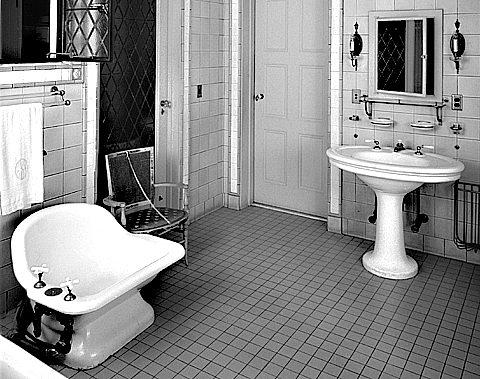
 decorative treatment. A common treatment was to have
decorative treatment. A common treatment was to have 
 A turn-of-the-century issue of Harper’s Bazaar featured a charming vintage bath with a light green tile wainscot and floor, and a paper above the wainscot with a design of dainty fleur-de-lis in lavender, green, and white. Dainty green muslin curtains hung at the windows, green and white rugs covered the floor, and all the fixtures were pure white. Another bathroom had a frieze of white seagulls against a delicate light blue background, blue and white rugs on the floor, and the tiles and other fixtures of white. A different issue described a luxurious bathroom with a white tiled floor and dado. On one side of the room the dado disappeared as mirrors paneled in gilt Empire frames came down to the floor. A pale pink stained glass filled the windows, which were draped with curtains of apple-green taffeta. The faucets were all gilded. No matter what the size, every housekeeper prided herself on her bathroom—the smallest and simplest being arranged with infinite care.
A turn-of-the-century issue of Harper’s Bazaar featured a charming vintage bath with a light green tile wainscot and floor, and a paper above the wainscot with a design of dainty fleur-de-lis in lavender, green, and white. Dainty green muslin curtains hung at the windows, green and white rugs covered the floor, and all the fixtures were pure white. Another bathroom had a frieze of white seagulls against a delicate light blue background, blue and white rugs on the floor, and the tiles and other fixtures of white. A different issue described a luxurious bathroom with a white tiled floor and dado. On one side of the room the dado disappeared as mirrors paneled in gilt Empire frames came down to the floor. A pale pink stained glass filled the windows, which were draped with curtains of apple-green taffeta. The faucets were all gilded. No matter what the size, every housekeeper prided herself on her bathroom—the smallest and simplest being arranged with infinite care. 



